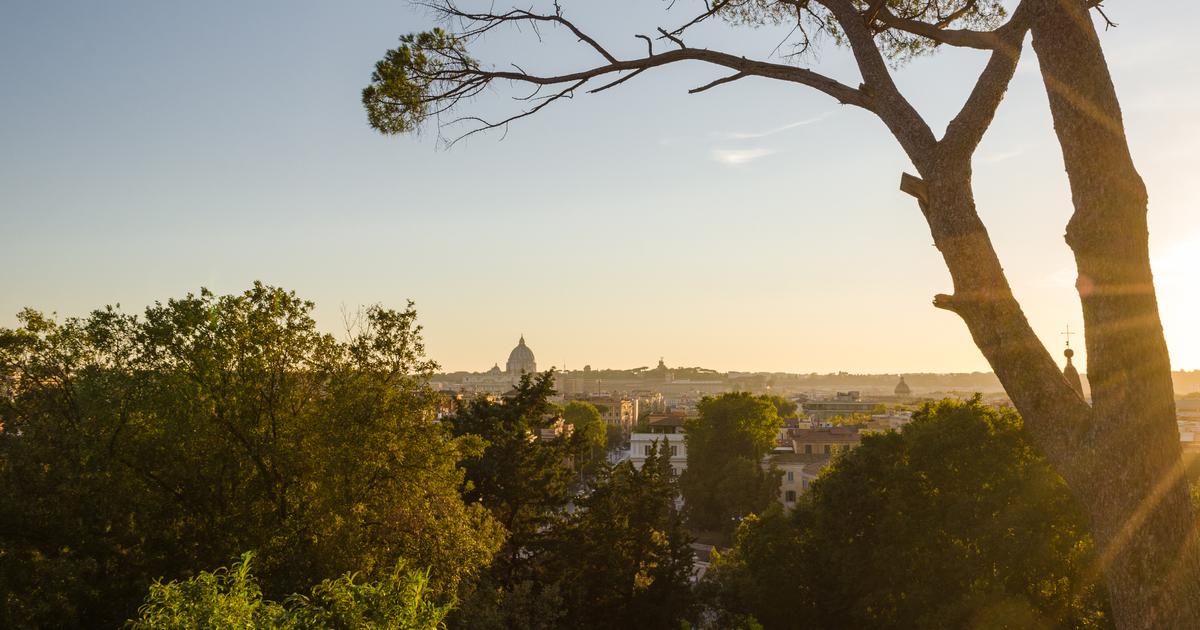Rome is an ocher and green city, dominated by umbrella pines, elegant silhouettes with rounded tops. Its tree cover, which represents almost a quarter of its urban territory according to a 2022 study by the European Environment Agency, makes it one of the greenest cities in Europe. A heritage that it owes to the great papal families, who built villas surrounded by hunting estates, such as the Villa Doria Pamphili, the largest in Rome, the Villa Ada and the Villa Borghese. But alongside these immense green expanses, there are more intimate gardens, public or private, perfect for a bucolic break.
The Farnese Gardens (Horti Farnesiani)
Located on the Palatine Hill, above the Domus Tiberiana, Rome's first imperial palace, reopened last September after 50 years of work, these topiary gardens were created by Cardinal Alessandro Farnese at the turn of the 16th century. Punctuated with aviaries, statues, plant sculptures and fragrant orange trees, the Farnese gardens, of which only a tiny part remains, express all the interest of Renaissance scholars in Antiquity. Peaceful and shaded, they offer one of the most beautiful views of the Forums.
Tickets on sale on the Colosseum archaeological park website, €16 entry.
L'Orto Botanico
Hidden from view in the heart of the Trastevere district, these 12 hectare gardens are part of Villa Corsini, a prestigious residence of the Roman nobility. Along the silent paths, we discover splendid monumental trees, cedars and century-old cork oaks, a magnificent collection of bamboos, but also Mediterranean plants without forgetting the greenhouses of orchids and succulent plants. Guided tours are strongly recommended for garden lovers.
Orto Botanico. Open every day from 9 a.m. to 5 p.m. From €5 entry.
Villa Sciarra
Still in the Trastevere district, but high up on the slopes of the Janiculum, this delightful public garden (sometimes a little abandoned) has a long history as evidenced by a 4th century Syriac temple. Its main building, the Casino Barberini, houses the Italian Institute of German Studies. Dotted with exotic plants, including ginko bilobas, the gardens have lovely fountains, astonishing statues and a turtle lake.
Villa Celimontana
On the Celio hill, between the Colosseum and the Baths of Caracalla, this public garden belongs to an aristocratic villa built in the 16th century on the site of ancient vineyards and groves. Home to the Italian Geographical Society, Villa Celimontana is a timeless place where ancient remains, Renaissance fountains, an Egyptian obelisk and a pretty neo-Gothic temple coexist.
The Colonna garden
Adjoining the grandiose palace of one of the most powerful Roman families, this garden, where Michelangelo lived, was built on the remains of a temple dedicated to Hercules and Dionysus. Ancient statues and Roman sarcophagi punctuate its paths lined with laurel and magnolias. At the top of the fountain, whose waters cascade down the Quirinal hill, the view dominates the domes of Rome up to St. Peter's Basilica.
Colonna Palace, from €15 entry.
The Aranci Garden
Also called Savello Park, this terraced public garden, offering a unique perspective on the dome of Saint-Pierre, overlooks the Tiber from the Aventine hill. Located behind the apse of the Basilica of Saint Sabina, adjoining the remains of a medieval fortress, the “Giardino degli Aranci” owes its name to its numerous orange trees cultivated in homage to Saint Dominic who is said to have brought back the first orange tree on Earth in the 13th century Saint, a miraculous tree, which he would have planted in this garden (in reality in the cloister of the basilica).
The Giardino Pensile Aldobrandini
It is surely one of the most secret public gardens in Rome. Surrounded by thick walls, it is located at the very beginning of Via Nazionale, at the corner with Via Panisperna, invisible from the street. Accessible from a flight of rather steep steps, the garden is a micro-oasis in the heart of Roman chaos, planted with pines, cypresses, an immense plane tree, decorated with a fountain and statues. From the Giardino Pensile Aldobrandini, we admire the Militia Tower, a vestige of medieval Rome.

